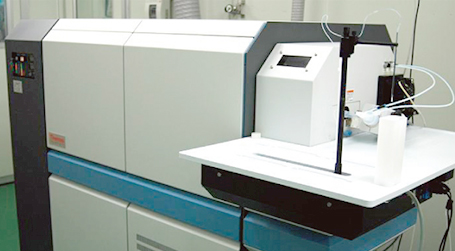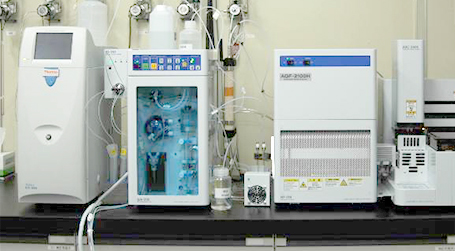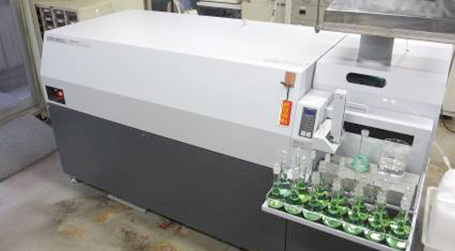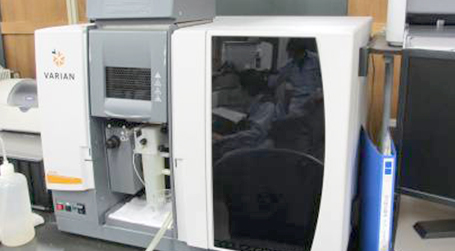Chemical Analysis
Trace Analysis
In research and development of the new advanced materials in which demand for higher purity and better functionality is increased it is important to determine the amount of trace elements added to major elements and to detect and quantify impurity elements if present.
In an early stage of research and development of the new advanced materials and manufacture of its prototype the sample quantity for analysis is often very limited.
JFE-TEC can respond to the client's needs in trace analysis by selecting the optimum sampling method and the optimum analysis method based on the predicted concentration of unknown elements and impurities allowing the trace analysis of the sample at minimum quantity with high accuracy and precision.
Analysis of Steel-Related Materials and Non-Ferrous Metals
-

-
High research activity to increase the purity of the steel-related materials and non-ferrous metals results in better understanding of the effects of trace elements in these materials and the way to control impurities for improving the performance and the functionality of products based on these materials. Importance of the trace analysis of elements and impurities with high accuracy and precision as well as high sensitivity is well recognized.
In trace analysis of the metal materials JFE-TEC uses a combination of the optimum sample preparation method in accordance with the sample composition with the optimum analytical method in accordance with the concentration of elements to be analyzed, thereby allowing the quantification of trace metal components, volatile components, and halogens.
Analysis Examples
- Analysis of Ultra-trace Amount of Residual Hydrogen
- Laser Ablation Inductively Coupled Plasma Mass Spectromethy(LA-ICP-MS)
- Ultra-Trace Analysis of Highly Pure Metals and Electronics Materials
Analysis of Advanced Materials (Analysis of Materials for Functional Products)
-
In research and development of the materials for functional products such as battery materials, semiconductor materials, magnets, target bodies, and thermoelectric materials it is important to identify the trace element species and to quantify their concentration.
JFE-TEC provides the analysis service of the atmospheric moisture and/or air-sensitive samples which are handled and analyzed in the cryogenic and humidity chamber or in a glove box filled with inert gas and the ultra-trace analysis of elements in the clean room for preventing the sample from contaminating with the analysis environment. Use of proper facilities ensures the accurate, reproducible analysis of these samples.
-
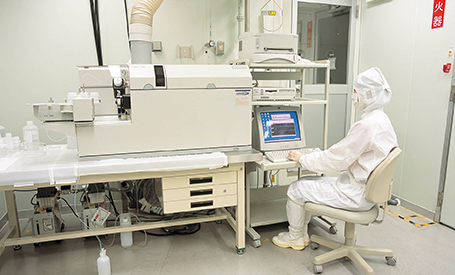
Analysis Examples
- Analysis of Battery Constituent Materials Based on Laser Ablation Inductively Coupled Plasma Mass Spectrometry (LA-ICP-MS)
- Ultra-Trace Analysis of Highly Pure Metals and Electronic Metals
- Ultra-Trace Elemental Analysis of the Silicon-On-Insulator Wafer for High Performance Devices And Silicon Carbide (Sic) Wafer for High Performance Power Electronic Devices
Chemical Analysis of Medical Devices and Medical Related Products
-
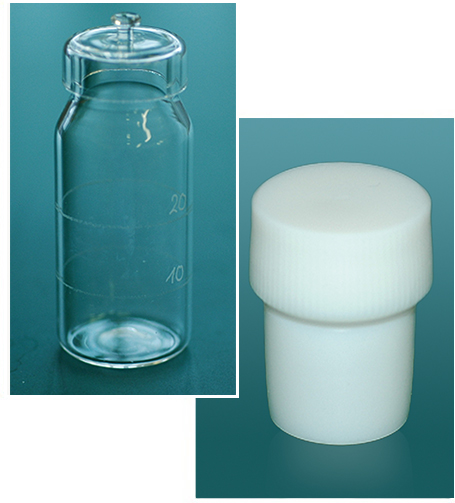
-
JFE-TEC can perform the elution test of materials used in medical devices and in implants for judging the biocompatibility of the materials, the analysis of impurities in medicinal drugs, and the trace analysis of impurities in chemical products and raw materials for them.
Please don't hesitate to contact us for the elution test to comply with the standards of JIS, ISO, and EN.
Selection of an Analysis Method and a Flow of the Analysis Procedure
Confirmation of specimen receipt JFE-TEC will inform the client to confirm sample receipt and propose the appropriate analysis method to the client.
Specimen Type for Analysis and Detection Limit
-
Specimen type for analysis and its shape
- Battery materials (cathode, anode, electrolytes)
- Alloys and sintered compact
- Rare earth magnets
- Carbon materials (graphite, carbon nanotube (CNT)), etc.
Specimen in a form of bulks, powders, and films can be analyzed by JFE-TEC.
-
Detection limit in trace analysis
Metal elements 1 ppm (ICP mass spectrometry) Sulfur (S) and halogens 5 - 10 ppm (combustion ion chromatography) * The detection limit may be varied with the amount of specimen and the elements to be analyzed.
In the samples with no knowledge of its composition and analysis of impurities the qualitative analysis may be firstly performed, followed by the quantitative analysis of the components detected.
Analysis Example of Lithium-Ion Secondary Battery
Chemical analysis of samples in trace quantities
A few tens of mg of the specimen is sufficient for the composition analysis and impurities analysis in trace quantities.
| Purpose | Analysis compositions | Analysis method |
|---|---|---|
| Composition analysis | Bismuth (Bi), tellurium (Te) | ICP atomic emission spectroscopy |
| Qualitative analysis | Impurity components | ICP mass spectrometry |
Analysis Example of Thermoelectric Element
-
High precision analysis of a small amount (5 mg) of specimen
A small amount of major components (Ni, Mn, Co, and Li) in the ternary cathode materials is quantified by the ICP optical emission spectroscopy and their results are shown below.
wt%
Element Content ± σ Lithium (Li) 6.82 ±0.16 Manganese (Mn) 16.7 ±0.4 Cobalt (Co) 18.8 ±0.4 Nickel (Ni) 17.6 ±0.4 -
Analysis of lithium in the anode when varying the charging rate
Disassembling of the batteries without exposing to the atmosphere is combined with the trace analysis technique to quantify lithium varied with the charging rate as well as to determine the irreversible capacity loss after cyclic charging.

Analysis Example of Rare Earth Magnet
-
Thermal demagnetization in inert atmosphere
The specimen is thermally demagnetized under the nitrogen atmosphere. Don't hesitate to contact us if you have any problem with thermal demagnetization of the samples.
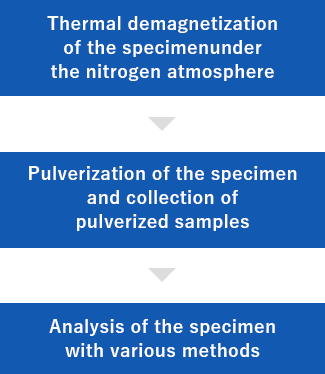
-
ICP atomic emission spectroscopy of rare earth metal components
In the analysis of rare earth metals such as neodymium (Nd) and dysprosium (Ds) interference spectrum are likely to affect the accuracy of analysis, but JFE-TEC has expertise and experience to eliminate the spectral interference.
Purpose Analysis compositions Analysis method Composition analysis Neodymium (Nd), Dysprosium (Dy),
Iron (Fe),
Boron (B)ICP atomic emission spectroscopy Qualitative analysis Impurity components ICP mass spectrometry



